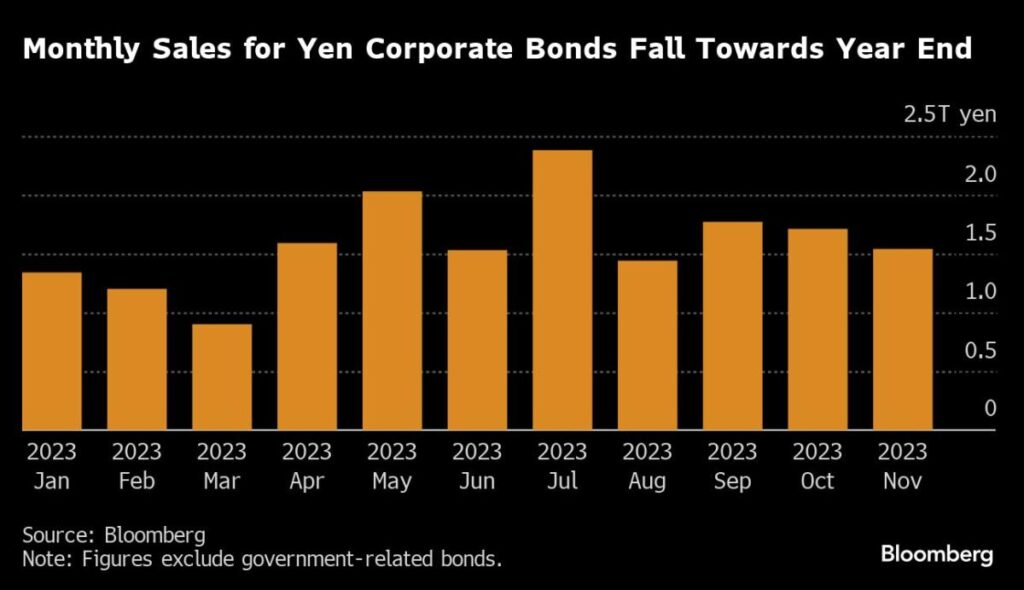(Bloomberg) — Years of ultra-low rates have created an enviable position for borrowers in the yen bond markets, as costs have stayed relatively low and stable. Now, speculation that the Bank of Japan will finally tighten policy is leaving the market exposed.
Most Read from Bloomberg
Investor demand for corporate bonds is weakening, even as companies rush to raise money to take advantage of low rates while they still can. Some deals have been scrapped amid market volatility, and borrowers are exploring new pricing structures to attract money.
“There is a sense of caution in the credit market that negative interest rates will be lifted at some point,” said Kentaro Harada, chief credit analyst at SMBC Nikko Securities Inc. “Investors are increasingly becoming selective, and premiums that they demand and what issuers want to offer are getting harder to match.”
All this points to an uncertain picture going into 2024 for the Japanese market, which until now has stood out globally by providing cheap funding opportunities when borrowing costs in other currencies have surged. Adding to the challenge is the risk that other major central banks may start cutting interest rates just as the BOJ starts rolling back its ultra-easy policy.
Bigger Spreads
Buyers are seeking wider spreads on yen-denominated bonds from Japanese and overseas issuers. At around 61 basis points, premiums are higher than the average for every year since the fallout of the financial crisis in 2009, according to a Bloomberg index. Spreads have experienced some relatively wide fluctuations in 2023, though, coming down from almost 68 basis points in March after the collapse of Silicon Valley Bank and Credit Suisse AG roiled global financial markets.
The gyrations make it more difficult for issuers to find pricing levels that meet investor demand, leading them to explore other structures, such as unrated bonds and rare floating-rate notes.
Sales Taper Off
Sales of yen-denominated corporate bonds from Japanese and foreign borrowers have declined for three straight months through November, according to data compiled by Bloomberg. That’s even as issuance has jumped 30% year-on-year to a record ¥17.7 trillion ($121 billion) in 2023 so far, with borrowers scrambling to get into the market before costs rise more.
This doesn’t bode well for this month, with only about ¥220 billion of deals in the pipeline from Japanese and overseas issuers. Added to the ¥298 billion of bonds that priced at the start of the month, that would still make for relatively low volume compared to some ¥2.3 trillion of yen-denominated bonds sold in December 2022.
Rising Rates
Fluctuating sovereign yields have led to an increasing number of corporate notes being priced on spreads over government bonds, a change to the practice of just setting a coupon, which was widely adopted after the BOJ introduced its negative rate policy in early 2016. This means that borrowers are now more exposed to volatility in the rates market, and that may make it more difficult for them to find the right pricing levels, especially at times when Japanese bond yields are moving a lot.
“The consensus is that rates will rise, so coupon pricing no longer fits the current market condition,” said Masahiro Koide, joint head of the products business division at Mizuho Securities Co. His data as of Dec. 1 show that about 95% of 10-year notes for institutional investors sold by Japanese companies since August, excluding highway operators, were priced on spread, compared with 26% between April and July. The shift quickened after the BOJ effectively loosened its cap on 10-year yields in late July.
Pulled Deals
There have been an unusually large number of deals scrapped this year because of fluctuations in the Japanese credit market. Bonds from energy supplier Iwatani Corp. and social network provider Gree Inc. are among at least 17 offerings that were either delayed or canceled this year. A long marketing period for debt sales compounds these issues.
Most Read from Bloomberg Businessweek
©2023 Bloomberg L.P.
Read the full article here

